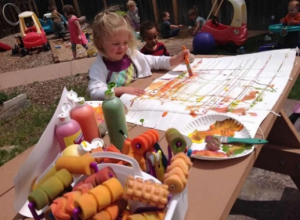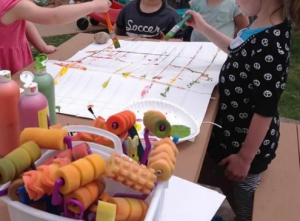Math Plus Art Equals Joyful Learning
Children have an innate sense of joy; to dream, learn, and seek wonder in everything. They have bright enthusiasm and endless curiosity. Just a brief conversation with a three-year-old will give you a sense of how beautiful they find the world. I strive to capture that magic when designing a math environment to meet a child’s curious nature. When building learning experiences, I also refer to the philosophies of Reggio Emilia and Waldorf. These perspectives recognize the child as capable and already having knowledge necessary for learning new things. Inspiration, creativity, and natural learning spaces are great additions to mathematical learning. Because the outdoors is filled with natural light and fresh air, these spaces can be essential for learning something new. Nature is full of fascinating objects that have multiple uses in a variety of activities. Children are inspired and more imaginative when they are surrounded by the calming effects of nature.
 Playful learning is the key. Children will easily build upon learning disguised as play. An enjoyable, emergent curriculum is one that is delightful and inquiry-focused. Asking children for their input will fuel their interest. They will naturally feel included as they recognize their own ideas in math activities. This ownership can make math visible in a way that children value and understand.
Playful learning is the key. Children will easily build upon learning disguised as play. An enjoyable, emergent curriculum is one that is delightful and inquiry-focused. Asking children for their input will fuel their interest. They will naturally feel included as they recognize their own ideas in math activities. This ownership can make math visible in a way that children value and understand.
Mathematics can sometimes be a challenging subject for adults which can create conflicting feelings about teaching it to children. Introducing it with art can be a relaxing way to bring new concepts to children and bring joy to teaching math. This creative duo is a wonderful way to encourage young children to form positive feelings about mathematics from the beginning of their educational journey.
During one of our learning adventures, we talked about all of the geometric shapes we can find in string art painting. Children will naturally become aware of spatial relationships as they manipulate shapes in their daily play. As they begin to recognize geometric shapes, they will advance to understanding how individual shapes make up part of a whole object. When offering these blended art experiences, I ask open-ended questions and let children’s answers direct the flow of learning. Spend time listening to children’s conversations and you will find surprise and inspiration. When I see inspiration, I realize other children are “seeing” it too. This is the activation of wisdom and it catches on like wildfire. I have found these playful sparks occur most often when children have plenty of time to explore and form thoughtful conclusions about their discoveries. 
Every child has unique gifts to share and teaching math with art gives children multiple ways to shine. Art is distinctly creative while at the same time allows for diversity. Presenting colorful math materials to children that are beautiful and inviting provokes thinking and wonder. Taking supplies outside brings together creativity, learning, and the beauty of a natural environment. With the warm sun and sweet breeze, children can be heard laughing, singing, and encouraging friends to “look at this!” It’s pure magic to see their artwork or what mathematical conclusions they have found.
Child can learn geometric shapes painting
Children can learn about geometric shapes with art
Painting and creating shapes is a fun math activity
painting with different textures makes great shapes and is a very good project to learn about shapes with art.